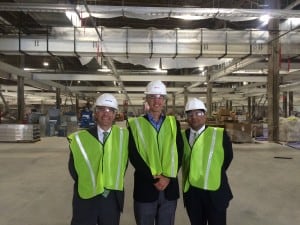I had the privilege of spending a full day in Buffalo last week before delivering a lecture on Regenerative Capitalism, at the invitation of Amit Goyal, Director of the State University of New York at Buffalo’s RENEW Institute. Regenerative thinking and action is what defines an emergent Buffalo. It is taking place across scales, and it is working at the edges of the private sector, the public sector, the non-profit sector, and the research university.
RENEW is an impressive “university-wide, interdisciplinary research institute that focuses on complex environmental issues, as well as the social and economic issues with which they are connected.” The seven participating schools include the College of Arts and Sciences, the School of Management, the School of Architecture and Planning, the School of Engineering and Applied Sciences, the Law School, the School of Public Health, and the School of Medicine. RENEW’s own vision calls for a regenerative economy, and even a one-day visit to Buffalo left me feeling the regeneration happening in real-time. It was yet another example, together with our now 35 “Field Guide” stories, which gives me confidence that regenerative economies are indeed an emergent phenomenon happening everywhere on the ground, often in distressed cities and communities where the pressure for change is the greatest. This is as expected, in accordance with our understanding from the science of physics and how natural systems change in response to pressure.
I experienced three distinct manifestations of regeneration during my Buffalo visit.
The RENEW Institute, with an impressive $25 million budget, is certainly a shining example of higher education commitment to interdisciplinary (integrated) thinking and work, the future of higher education in this integral age. Amit likes to say they are looking for “T people” as opposed to “I people” to join the institute. An “I person” is the traditional academic expert, with deep knowledge within his or her field. A “T person” on the other hand, must demonstrate deep knowledge within a discipline but also be a lateral thinker who can integrate ideas and discover new potential and solutions by working across silos. This is no easy feat as anyone familiar with the academy can attest. Listening to Amit during my visit, and to the Provost during the introduction to my lecture, I got the sense that the University is bound and determined to work at what we like to call the “edges” – the boundaries where different systems (or in this case disciplines) meet – leveraging its considerable domain expertise while at the same time forging relationships of exchange where the real regenerative potential lies.
The second manifestation of regeneration happening on the ground is the People United for Sustainable Housing (PUSH) Buffalo initiative, under the leadership of the energetic Aaron Bartley. Bartley is a Harvard Law grad who returned to his hometown to contribute to its regeneration after decades of decay from what was once one of America’s leading and wealthiest cities when it served as a vital trade hub. Ten years young, PUSH and its partners have transformed neighborhoods one building at a time – inspiring work. Walking block by block with Aaron and sharing brief greetings with local residents, the regeneration was palpable.
Finally, there is the Buffalo Billion, a signature economic development project of Governor Cuomo, who has committed to invest $1 billion into the Buffalo economy. A central premise of regenerative economics is what we call “robust circulation.” This includes ample reinvestment in the economic system to ensure its vitality. Too often wealth is extracted from regions and reinvested elsewhere. Faced with decline often caused by external shocks, modern austerity ideology in the name of balanced budgets (see Europe post-financial crisis) only furthers economic decline by starving a community of the vital reinvestment all healthy systems demand. After decades of disinvestment and decline, it is vitally important that the public sector engages in Buffalo’s regeneration in order for it to succeed. The city is very fortunate to have been selected by Governor Cuomo as the target for such large-scale investment.
I was given a tour of the massive solar manufacturing facility being built for SolarCity. At an astonishing 28 acres under one roof, it will be one of the world’s largest and most sophisticated solar manufacturing facilities when it is complete. While the solar plant is but one aspect of the Buffalo Billion, it represents the majority of the funds being invested in an innovative public-private partnership under which the State will actually own the plant.
Our regenerative framework favors a more diversified, risk-mitigating investment strategy, and a greater focus on vital, enabling infrastructure and education than on individual enterprises. That said, if successful, the new solar facility will no doubt create a regional hub for innovation and employment, and generate tax revenue that will support the infrastructure improvements the city so sorely needs. The regenerative potential of a project of this scale, coupled with all the other positive things happening in town is truly impressive.
Not to mention that Buffalo is nicely situated with respect to water and climate for the future. We will be back this summer for the New Economy Coalition’s CommonBound (July 8-10). Watch this space!


